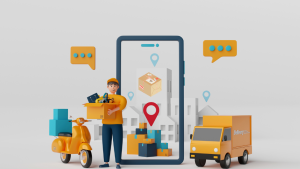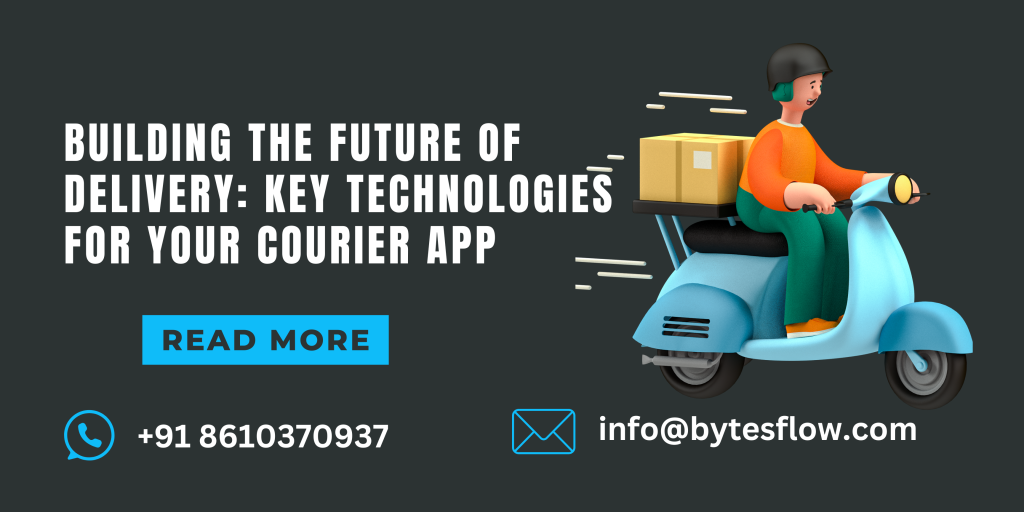The digital era has brought massive changes to the courier delivery industry, revolutionizing how packages are tracked, secured, and delivered. For businesses aiming to enter this profitable courier delivery market, leveraging the right technologies is crucial for a successful and competitive on-demand courier delivery app development. In this blog, let’s explore the must-have technologies for courier delivery app development that are efficient, competitive, and built to meet evolving customer expectations.
Essential Technologies For a Successful On-Demand Courier Delivery App Development

1. Real-Time GPS Tracking and Mapping Technology
Real-time GPS tracking is at the core of modern courier delivery apps. This provides both businesses and customers with live updates on package locations and delivery progress. Using technologies like GPS integration and APIs such as Google Maps and Mapbox, this feature enables precise location tracking and route optimization.
Incorporating real-time GPS tracking while your on-demand courier delivery app development enhances transparency. This allows customers to know exactly when their packages will arrive. Additionally, it helps drivers find the most efficient routes, minimizing delays and increasing overall delivery speed. By improving delivery times and offering accurate ETAs, GPS tracking builds trust with customers, who appreciate the visibility it provides.
2. Artificial Intelligence (AI) and Machine Learning (ML)
Artificial Intelligence (AI) and Machine Learning (ML) have transformed various industries, and courier delivery is no exception. These technologies allow courier apps to process vast amounts of data to improve operations and personalize user experiences. By implementing AI algorithms and ML for predictive analytics during your on-demand courier delivery app development, it can become highly efficient and user-centric.
AI can help optimize routes, predict delivery demand, and personalize delivery windows, making operations smoother and cost-effective. For example, during peak hours, AI can suggest alternative routes for faster deliveries, while ML can analyze historical data to predict high-demand areas. This level of intelligence reduces operational costs and increases delivery accuracy, ultimately benefiting both businesses and customers.
3. Internet of Things (IoT) for Smart Package Tracking
The Internet of Things (IoT) is crucial for advanced package tracking, especially for items that require extra care, like perishable goods or pharmaceuticals. By using IoT-enabled sensors, courier companies can track packages’ location, temperature, and handling status in real time. This provides an additional layer of security and monitoring.
IoT technologies like RFID and Bluetooth Low Energy (BLE) allow packages to be tracked continuously, alerting customers and businesses if a package is tampered with or exposed to damaging conditions. This technology is invaluable for sensitive shipments, as it helps prevent damage, ensures proper handling, and maintains quality during transit, making IoT a game-changer in high-stakes deliveries.
4. Blockchain for Security and Transparency
Blockchain technology has become synonymous with security and transparency, making it ideal for on-demand courier delivery app development, particularly for high-value items. Blockchain’s decentralized ledger system ensures that transactions are secure and immutable, while smart contracts automate and verify delivery processes.
By preventing data tampering and offering transparent tracking logs, blockchain builds trust with customers who rely on accurate delivery information. In industries like finance or luxury goods, where security is a top priority, blockchain technology adds a layer of security and reliability. This makes courier services safer and more transparent.
5. Cloud Computing for Scalability and Data Management
Cloud computing has transformed data storage and processing, allowing courier apps to scale efficiently and manage large amounts of data. Services like AWS, Microsoft Azure, and Google Cloud provide on-demand access to storage and computing resources, making it easier for companies to handle peak loads.
Cloud computing also ensures data accessibility across distributed teams, enabling seamless coordination. Moreover, with built-in data backup and disaster recovery options, cloud computing minimizes downtime, making courier apps more resilient and responsive to customer demands.
6. In-App Chat and Communication Technologies
In-app chat features are essential for seamless communication in on-demand courier delivery app development. Because they allow customers, drivers, and support teams to stay connected. Integrating communication technologies, like Twilio or Firebase, facilitates real-time messaging, enhancing customer service and resolving issues faster.
By enabling live chat, push notifications, and real-time updates, customers can get instant support, while drivers can receive updates on deliveries without delays. This instant communication improves reliability and makes the delivery experience smoother for everyone involved.
7. Secure Payment Gateways and Digital Wallet Integration
Payment security is vital in on-demand courier delivery app development, especially with the growing adoption of digital payments. Using reliable payment gateways like Stripe, PayPal, Apple Pay, or Google Pay provides customers with secure and convenient payment options.
Integrating multiple payment options enhances user experience, while features like encryption and two-factor authentication build trust. Providing various options like credit cards, digital wallets, and cash on delivery ensures that users have the flexibility they need, making the checkout process quick and reliable.
8. Data Analytics and Business Intelligence
Data analytics and business intelligence (BI) have become fundamental in on-demand courier delivery app development. This offers insights that inform strategic decision-making. With tools like Google Analytics, Tableau, and Apache Spark, courier companies can analyze customer behavior, identify peak delivery times, and optimize resource allocation.
Data-driven insights allow companies to improve service areas, predict demand fluctuations, and boost customer satisfaction by tailoring services. By using analytics to fine-tune operations, courier delivery apps can stay competitive and responsive to changing market demands.
9. Autonomous and Drone Technology for Advanced Delivery Options
Autonomous vehicles and drone technology represent the future of courier deliveries, offering efficient and cost-effective solutions for last-mile delivery. By using autonomous vehicle software and GPS-based navigation, drones and automated vehicles can deliver packages directly to customers, particularly in congested or remote areas.
Implementing this technology in your on-demand courier delivery app development can reduce labor costs, increase delivery times, and provide services where traditional delivery is challenging. Although still emerging, autonomous and drone delivery is a game-changer, opening up new possibilities for fast and efficient deliveries.
10. Augmented Reality (AR) for Seamless Delivery Experience
Augmented Reality (AR) offers courier delivery apps a unique way to engage customers and assist drivers in navigation. By using AR tools like ARKit and ARCore, apps can create in-app visualizations, such as drop-point markers or package placement guides, enhancing the user experience.
For customers, AR allows them to view drop points or visualize where packages should be placed. This can be useful for package retrieval in shared spaces. By simplifying navigation and enhancing the delivery process, AR adds value and makes the delivery experience more intuitive.
11. Predictive and Preventive Maintenance with Big Data
Implementing predictive maintenance powered by big data in your on-demand courier delivery app development ensures that vehicles and equipment remain in optimal condition, minimizing breakdowns and delivery disruptions. Platforms like Hadoop enable courier companies to analyze data for patterns that signal maintenance needs before issues arise.
By monitoring fleet health, tracking fuel usage, and receiving alerts for preventive maintenance, courier apps can reduce downtime, lower operational costs, and ensure timely deliveries. Predictive maintenance is a smart approach that boosts operational efficiency, helping your courier delivery app script stay reliable and proactive.
Key Technologies for Your On-Demand Courier Delivery App Development
Incorporating the right technologies is key for successful on-demand courier delivery app development to stand out in today’s competitive market. From real-time GPS tracking and AI-powered analytics to blockchain security and IoT-based package monitoring, these technologies improve efficiency. These also enhance customer satisfaction and create a resilient infrastructure.
By investing in these must-have technologies, courier companies can offer a high-quality, secure, and streamlined service that keeps pace with industry innovations and meets the expectations of modern consumers.
